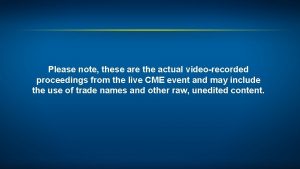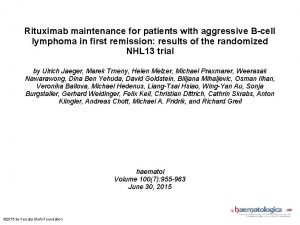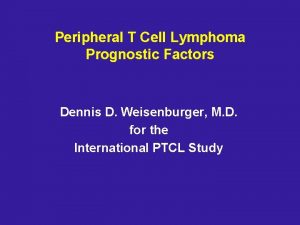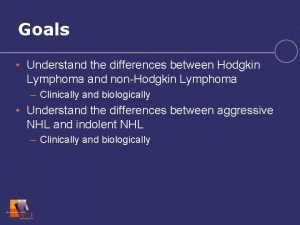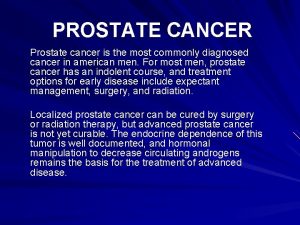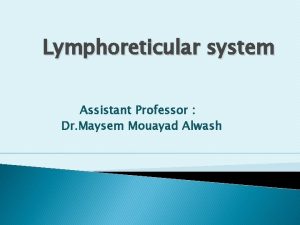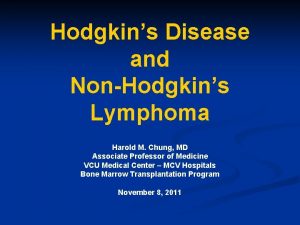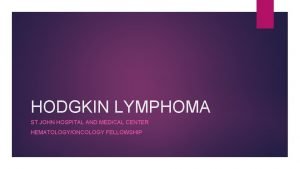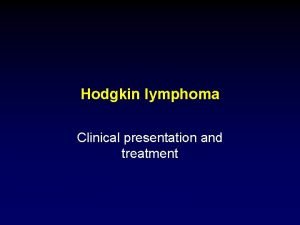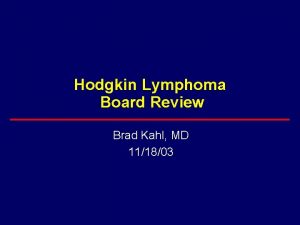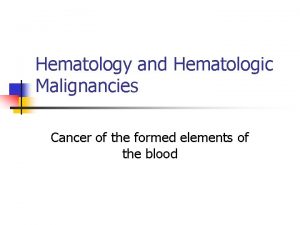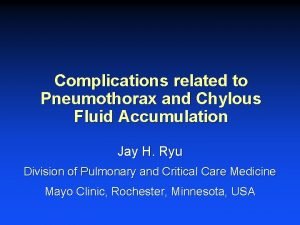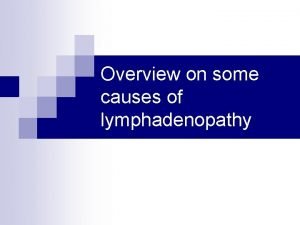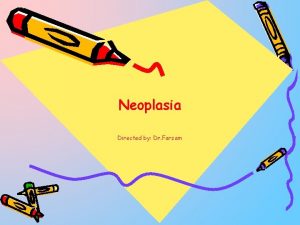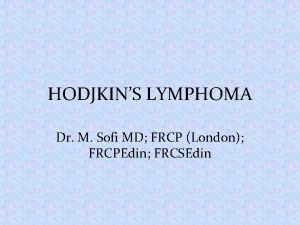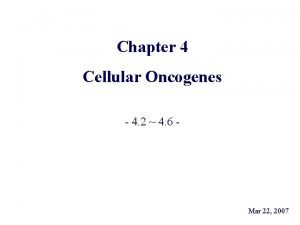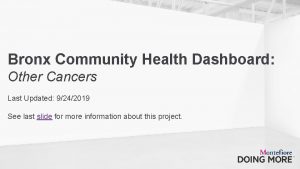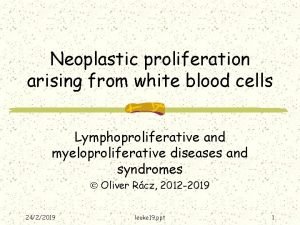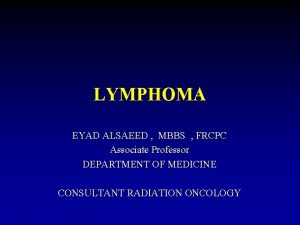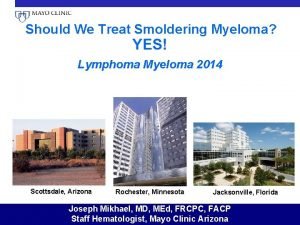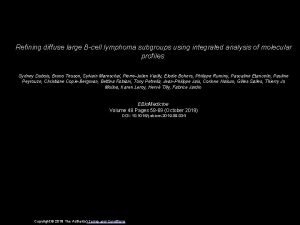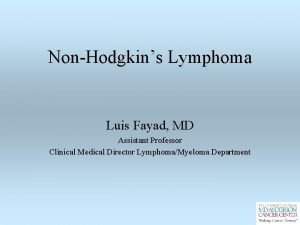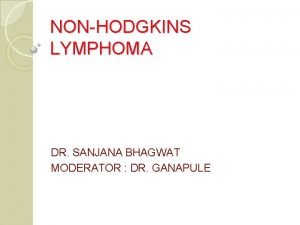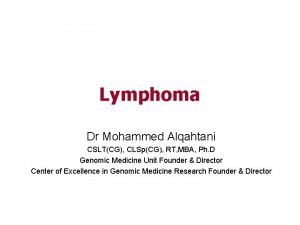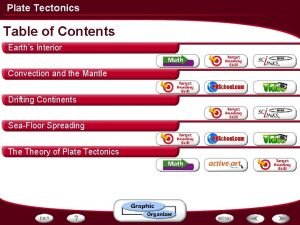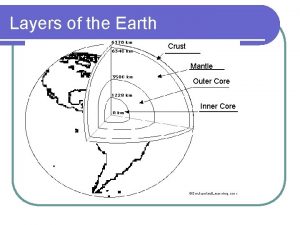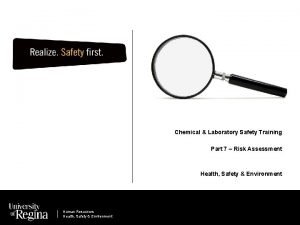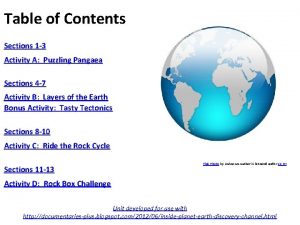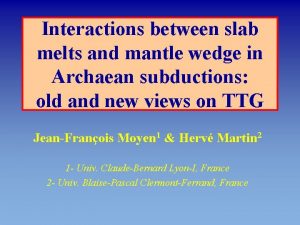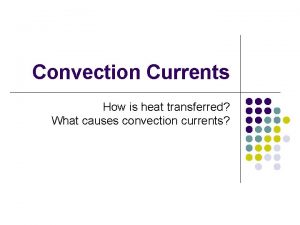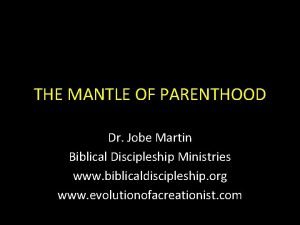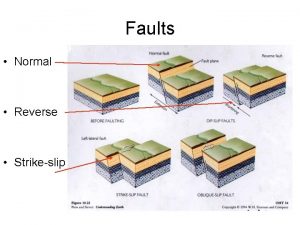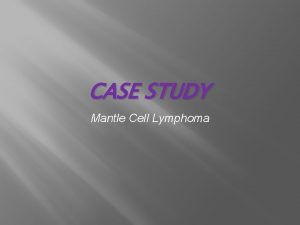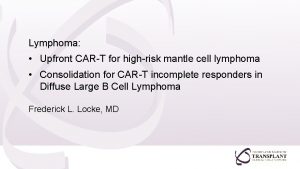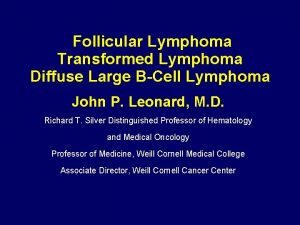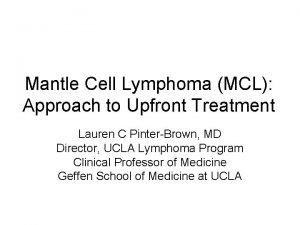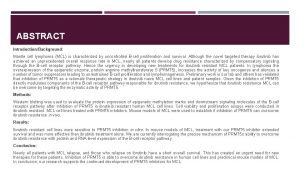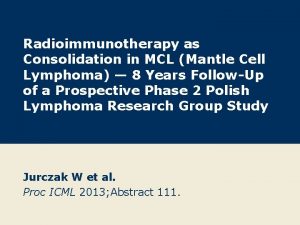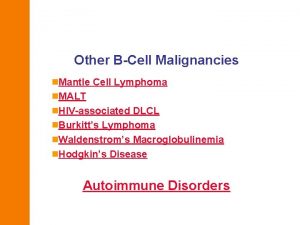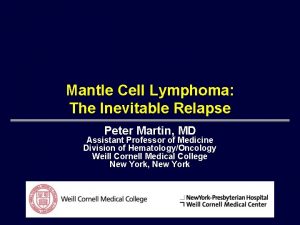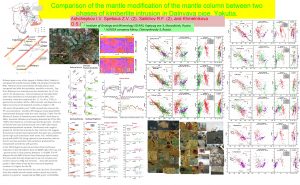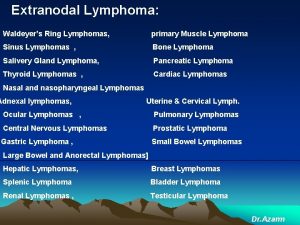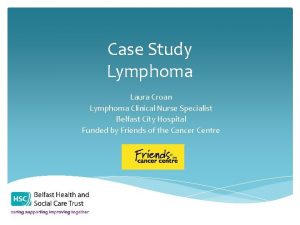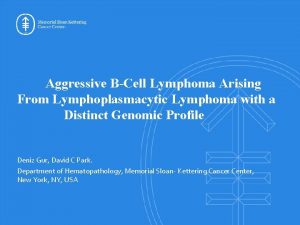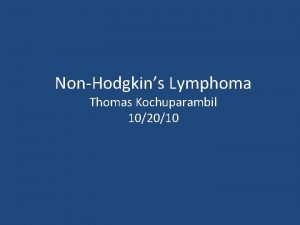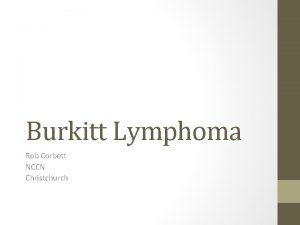General Overwiew New Approach to Mantle Cell Lymphoma
























































- Slides: 56

General Overwiew: New Approach to Mantle Cell Lymphoma Dr. Mustafa ÇETİN, Kayseri-2017

Subtypes of NHL Burkitt (2. 5%) Mantle cell (6 -8 %) Follicular (25%) Other subtypes (9%) Small lymphocytic lymphoma/CLL (7%) T and NK cell (12%) Diffuse large B cell (30%) MALT-type marginal-zone B cell (7. 5%) Nodal-type marginal-zone B cell (< 2%) Lymphoplasmacytic (< 2%) Mantle cell lymphoma comprises about 7 percent of adult non-Hodgkin lymphomas in the United States and Europe with an incidence of approximately 4 to 8 cases per million persons per year

MCL: Clinical Features q Accounts for ~ 6% of B-cell NHL cases q Typically a disease of the elderly Median age greater than 65 years old, 74% male q Generally regarded as aggressive and incurable q Indolent presentation, 10 -15% Armitage JO. Oncology (Williston Park). 1998; 12(10 suppl 8): 49 -55. Fisher RI, et al. Hematology Am Soc Hematol Educ Program. 2004: 221 -226. O’Connor OA, et al. Leuk Lymphoma. 2008; 49(Suppl 1): 59 -66.

MCL: Clinical Features q > 90% stage III/IV, including marrow involvement q Blood (lymphocytosis), and lymphadenopathy (75 -90 %) q Extranodal sites common a) GI (upper and lower, can present as lymphomatous polyposis coli), (25 %) b) CNS involvement rare (<5%) c) Leukemic phase, PB flow commonly positive Most patients present with advanced stage disease. . Cheah CY, et al. Ann Oncol. 2013; 24: 2119 -2123

Pretreatment Workup History and physical examination Evidence of GI blood loss? Early satiety Pretreatment evaluation CBC, COMP, LDH, B 2 M, IF, quantitative immunoglobulins HBs. Ag, hep B core Ab (hep B PCR if either is positive) Diagnostic CT with PET GI tract involvement by PET may be unreliable Panendoscopy Controversial; does it change treatment? Depends on goals of therap Establish bleeding risk: if negative, no need to repeat to confirm CR Echocardiogram When appropriate: pregnancy testing

MCL: Critical Role of Cyclin D 1 100 Some cases of MCL express cyclin D 2 or D 2 H&E OS (%) 80 60 All patients Cyclin D 1+ Cyclin D 1 - 40 P =. 0002 20 0 Cyclin D 1 0 5 Yrs 10 15 Nuclear staining for cyclin D 1 (BCL-1) is present in >90 percent of cases, including those that are CD 5 negative. This research was originally published in Blood. Yatabe Y, et al. Blood. 2000; 95: 2253 -2261 © the American Society of Hematology.

The histologic pattern of MCL Mantle Zone 5% to 7% Nodular type 10% to 15% Diffuse type Blastoid type 70 % to 75% 5% to 7% The histologic pattern of MCL may be diffuse, nodular, or mantle zone, or a combination of the three. Most cases are composed exclusively of small to medium-sized lymphoid cells, with slightly irregular or "notched, " nuclei Jares P, et al. Nat Rev Cancer. 2007; 7: 750 -762

MCL: Pathology CD 20 Cyclin D 1 CD 5 BCL 2 Typical immunophenotype: CD 20+, CD 5+, CD 23 -, CCND 1+, FMC 7+, BCL 2+ Dual-color, dual-fusion translocation DNA probe, ) identifying the presence of the t(11; 14) [IGH, 14 q 32/CCND 1, 11 q 13]. Mantle cell tumor cells express high levels of surface membrane Ig. M and Ig. D (s. Ig. M±Ig. D), which is more often of lambda light chain type. They also express pan-B cell antigens (eg, CD 19, CD 20), CD 5, and FMC 7. Nuclear staining for cyclin D 1 (BCL-1) is present in >90 percent of cases, including those that are CD 5 negative. (See 'Immunophenotype' above. ) ●Although not specific for MCL, the majority of cases will demonstrate t(11; 14) by conventional cytogenetics or FISH

MCL: Flow cytometry MCL express high levels of surface membrane Ig. M and Ig. D (s. Ig. M±Ig. D), . They also express pan-B cell antigens (eg, CD 19, CD 20), CD 5, and FMC 7.

MCL International Prognostic Index Survival in MCL by MIPI Risk Group 1. 0 Probability of OS 0. 8 Low 0. 6 0. 4 Int 0. 2 0 4 factors associated with OS Age ECOG PS LDH WBC Risk group definitions Low risk (< 5. 7) High Int. risk (≥ 5. 7 to < 6. 2) 0 12 24 36 48 60 72 84 96 Mos Since Registration This research was originally published in Blood. Hoster E, et al. Blood. 2008; 111: 558 -565 © the American Society of Hematology. Online MIPI calculator: www. europeanmcl. net/en/clinical_mipi. php. High risk (≥ 6. 2) Risk groups are well separated

Simplified MIPI Points Age, Yrs ECOG PS LDH, x ULN WBC, 109/L 0 < 50 0 -1 < 0. 67 < 6. 7 1 50 -59 -- 0. 67 -0. 99 6. 7 ≤ 10 2 60 -69 2 -4 1. 0 -1. 49 10 ≤ 15 3 ≥ 70 -- > 1. 5 ≥ 15 Risk groups Low risk: 0 -3 points Intermediate risk: 4 -5 points This model provides good curve separation in the dataset without calculation High risk: 6 -11 points This research was originally published in Blood. Hoster E, et al. Blood. 2008; 111: 558 -565 © the American Society of Hematology. Online MIPI calculator: www. europeanmcl. net/en/clinical_mipi. php.

Current first-line therapy pathway for MCL Elias Campo, and Simon Rule Blood 2015; 125: 48 -55


Rare and incurable Left image: HMRN statistics downloaded from https: //www. hmrn. org/statistics/incidence. Data shown for mantle cell lymphoma incidence as a percentage of all haematological malignancies; Right image: Abrahamsson et al, Leukaemia & Lymphoma 2011. Swedish lymphoma registry data showing overall survival in days for 785 patients diagnosed with MCL before or after 2006

Most not fit for intensive therapy Median age is 73 years 2/3 not fit for intensive approaches Source: HMRN https: //www. hmrn. org/statistics/incidence 31% Haematological Malignancy Research Network 69%

Is VR-CAP better than RCHOP? • VR-CAP (LYM-3002 trial) • Untreated MCL unsuitable for transplant Robak et al, NEJM 2015. 487 patients. VR-CAP vs RCHOP: toxicity (serious adverse events 38% vs 30%, peripheral neuropathy 30% vs 27% ). Higher CR (53% vs 42%) and PFS rates (25 vs 14 months) for VR-CAP

Is VR-CAP better than RCHOP? Higher CR (53% vs 42%) and , PFS rates (25 vs 14 months) for VR-CAP Robak et al, NEJM 2015. 487 patients.

Is R-Bendamustine better than RCHOP? PFS STi. L NHL 1 -2003 trial ; PFS data shown for MCL subgroup (94/560 patients). Longer PFS and less toxicity for R-bendamustine … Rummel et al Lancet 2013. Comparable response rates, higher PFS and less toxicity for R-bendamustine, no survival data presented.

Can Cytarabine improve survival? 6 year follow-up of MCL 2 trial • Ara. C prolongs survival in young patients treated intensively • Can Ara-C improve survival in the elderly? MCL 2: maxi. CHOP x 3 alternating with R- ARA-C x 3 + BEAM ASCT vs MCL 1: maxi. CHOP x 4 + BEAM ASCT Geisler et al, BJH 2012.

R-B plus cytarabine? R-BAC 500 • CGA ‘fit’ pts aged 61 -80 with untreated MCL: Induction phase x 6 cycles q 3 weeks Rituximab (375 mg/m 2) Phase ll trial Bendamustine (70 mg/m 2) Untreated MCL 57 elderly patients. Cytarabine (500 mg/m 2) Day 1 2 3 4 Visco et al, 13 -ICML 2015. Median age 71 (61 -79) 91% advanced stage disease, 45% high MIPI, 9% blastoid. Median 5. 3 cycles delivered/pt. Median FU 18 months

R-B plus cytarabine? R-BAC 500 Ongoing phase ll trial of RBAC-500 in untreated MCL in the elderly. Visco et al, 13 -ICML 2015 2 year PFS compares favourably with R-B but longer follow-up needed to establish any survival advantage

European MCL Elderly trial Maintenance continued until progression Kluin Nelemans et al, NEJM 2010. Median survival not reached at median follow-up of 36 months

European MCL Elderly trial 4 yr survival 87% for RCHOP followed by maintenance Rituximab Kluin Nelemans et al, NEJM 2010. Median survival not reached at median follow-up of 36 months

Short survival for those who relapse after ASCT Eligible patients were aged 18 years or more who underwent a first auto. SCT for MCL between 2000 and 2009, subsequently relapsed, and were registered with the EBMT database Dietrich et al, Annals of Oncology 2014. EBMT data. ASCT = autologous stem cell transplant

Inevitable relapse MCL 2 regimen Rummel et al Lancet 2013. STi. L NHL 1 -2003 trial Eskelund et al, BJH 2016. 15 year follow-up of MCL 2 trial

Short survival for those who relapse after ASCT • Relapse rate 47% at 5 years • Median survival of 19 months • Very short survival for relapse <12 months of ASCT Eligible patients were aged 18 years or more who underwent a first auto. SCT for MCL between 2000 and 2009, subsequently relapsed, and were registered with the EBMT database Dietrich et al, Annals of Oncology 2014. EBMT data. ASCT = autologous stem cell transplant

Options for relapsed/refractory MCL Drug No. pts ORR (CR) % Median DOR (mo) Median PFS (mo) Median OS (mo) Reference Ibrutinib 1 111 68 (21) 17. 5 13. 9 NR Wang et al, NEJM 2013 R-B 2* 24* 71 (38) 17. 6 35. 3 FR 2* 23* 26 (13) 4. 7 20. 9 Rummel et al, Lancet Oncology 2016 Lenalidomide 3 170 40 (5) 16 8. 7 27. 8 Chemotherapy 3 84 11 (0) 10. 4 5. 2 21. 2 Trněný et al, Lancet Oncology 2016 Temsirolimus 4 54** 22 (2) 7. 1 4. 8 12. 8 Hess et al, JCO 2009 Chemotherapy 4 53 2 (0) NA 1. 9 9. 7 ORR = overall response rate; DOR = duration of response; PFS = progression-free survival; OS = overall survival ; NA = not available; R-B = rituximab and bendamustine; FR = fludarabine and rituximab; mo = months; NR = not reached; *results shown for subset with mantle cell lymphoma; **results shown for 175/75 mg dose group. 1 = PCYC-1104 pivotal phase ll trial; 2 = STi. L trial; 3 = SPRINT trial (Single agent chemotherapy = rituximab, gemcitabine, fludarabine, chlorambucil, or cytarabine); 4 = OPTIMAL trial (single agent chemotherapy = gemcitabine, fludarabine, chlorambucil, cladribine, etoposide, cyclophosphamide, thalidomide, vinblastine)

R-bendamustine for relapsed MCL Rummel M et al. Lancet Oncology 2016; . 230 patients (47 with mantle cell lymphoma)

R-bendamustine for relapsed MCL R-B superior to FR for CR (38 vs 13%), median PFS (18 vs 5 months) and median survival (35 vs 21 months) Rummel M et al. Lancet Oncology 2016; . 230 patients (47 with mantle cell lymphoma)

Lenalidomide for relapsed MCL (SPRINT) Phase ll, randomised (SPRINT trial) 254 patients 2: 1 randomisation Arm A (84 patients) Investigator’s choice chemotherapy (choice of rituximab, gemcitabine, fludarabine, chlorambucil, cytarabine)* Arm B (170 patients) Lenalidomide 25 mg daily on days 1 -21 of a 28 day cycle Until PD or intolerability Trněný et al, Lancet Oncology 2016. The investigator agent of choice was given as follows: rituximab 375 mg/m 2 intravenously on days 1, 8, 15, and 22, and then once every 56 days; gemcitabine 1000 mg/m 2 intravenously on days 1, 8, and 15 every 28 days; fludarabine either 25 mg/m 2 intravenously or 40 mg/m 2 orally on days 1– 5 every 28 days; oral chlorambucil 40 mg/m 2 per month divided over 3– 10 days; or cytarabine 1– 2 g/m 2 intravenously once or twice daily on days 1 and 2 every 28 days. Chlorambucil and rituximab were given until progressive disease, intolerance, or voluntary withdrawal; cytarabine, fludarabine, and gemcitabine were given for a maximum of six cycles.

Lenalidomide for relapsed MCL (SPRINT) Trněný et al, Lancet O sly on days 1, 8, 15, and 22, and then once every 56 days; gemcitabine 1000 mg/m 2 intravenously on days 1, 8, and 15 every 28 days; fludarabine either 25 mg/m 2 intravenously or 40 mg/m 2 orally on days 1– 5 every 28 days; oral chlorambucil 40 mg/m 2 per month divided over 3– 10 days; or cytarabine 1– 2 g/m 2 intravenously once or twice daily on days 1 and 2 every 28 days. Chlorambucil and rituximab were given until progressive disease, intolerance, or voluntary withdrawal; cytarabine, fludarabine, and gemcitabine were given for a maximum of six cycles.

Overview of Study Results of Ibritunib Study Population Ibrutinib N Median PFS Median OS OS ORR NR – not reached Discontinuation rate due to AEs RAY 1104 Relapsed/ Refractory Monotherapy/ Temsirolimus Monotherapy 139 11 14. 6 months 57% reduction 13 months - 41% @ 24 months 31% @ 24 months NR 24% reduction 22. 5 months - 68% @ 12 months 47% @ 24 months 71. 9% 67% 6% 9%

N=280 Ray trial Ibrutinib versus Temsirolimus in Relapsed or Refractory Mantle Cell Lymphoma • Phase 3, International, openlabel, randomized, multicenter study • Relapsed or refractory MCL; at least 1 prior rituximab-containing therapy Dreyling et al, Lancet 2016

Ray trial Two year PFS 41% vs 7% Ibrutinib Median: 14. 6 months Temsirolimus Median: 6. 2 months • ibrutinib reduced risk of disease progression compared with temsirolimus (p < 0. 0001) Dreyling et al, Lancet 2016

% of patients ORR Is Higher for Ibrutinib-Treated Patients 100 IRC Assessment 80 ORR: 71. 9 vs 40. 4% (p < 0. 0001) 60 18. 7 53. 2 40 1. 4 39. 0 30. 5 20 10. 8 0 CR PR SD Ibrutinib (N = 139) 16. 3 10. 8 PD CR PR SD PD Temsirolimus (N = 141) Median duration of response: not reached (95% CI, 16. 2 -NE) with ibrutinib vs 7. 0 months (95% CI, 4. 2 -9. 9) for temsirolimus 35 Rule S et al. ASH 2015; Abstract 469 (Oral Presentation)

Overall Survival Ibrutinib Median: Not yet reached Temsirolimus Median: 21. 3 months • No statistically significant difference in survival* (1 -year survival 68% for ibrutinib vs 61% for temsirolimus) Dreyling M et al. Lancet 2016; 387(10020): 770 -8 *Study was not powered to detect a statistically significant difference in OS

Time to Clinically Meaningful Improvement on the FACT-Lym Lymphoma Subscale Clinically meaningful improvement was defined as a ≥ 5 -point increase from baseline on the FACT-Lym lymphoma subscale score A greater proportion of patients treated with ibrutinib had a clinically meaningful improvement in lymphoma symptoms vs. those treated with temsirolimus (86 [62%] vs. 50 [35%]) Improvement in symptoms occurred more quickly with ibrutinib vs. temsirolimus, with a median time to clinically meaningful improvement of 6. 3 (IQR NE) weeks vs. 57. 3 (101. 4) weeks, respectively (p < 0. 0001) Dreyling M et al. Lancet 2016; 387(10020): 770 -8

Common Treatment-Emergent Adverse Events (20% or More of Patients) in the Safety Population Ibrutinib (n = 139) AE, n (%) Temsirolimus (n = 139) Any Grade ≥ 3 Thrombocytopenia 25 (18) 13 (9) 78 (56) 59 (42) Anemia 25 (18) 11 (8) 60 (43) 28 (20) Neutropenia 22 (16) 18 (13) 36 (26) 23 (17) Diarrhea 40 (29) 4 (3) 43 (31) 6 (4) Fatigue 31 (22) 6 (4) 40 (29) 10 (7) Cough 31 (22) 0 Pyrexia 23 (17) 1 (1) 29 (21) 3 (2) Nausea 20 (14) 0 30 (22) 0 Peripheral oedema 18 (13) 0 31 (22) 3 (2) Epistaxis 12 (9) 1 (1) 33 (24) 2 (1) 4 (3) 0 29 (21) 5 (4) Hematological Non-hematological Rates shown are not adjusted for differences in exposure Stomatitis Median treatment duration was four times longer for the ibrutinib group (14· 4 months) vs. temsirolimus (3· 0 months) Despite the time difference in exposure, overall frequencies of most cumulative TEAEs were lower with ibrutinib Dreyling M et al. Lancet 2016; 387(10020): 770 -8

Conclusions Ray trial 1. Results of this phase 3 trial confirm efficacy and favorable safety profile of ibrutinib 2. Results also confirm the positive benefit-risk ratio for ibrutinib as an effective targeted approach in R/R MCL 3. Demographic characteristics at baseline were reflective of target patient population, supporting the application of these results to the general MCL population 4. Future research should investigate ibrutinib-based combination approaches for patients with relapsed or refractory MCL and in front-line therapy Dreyling M et al. Lancet 2016; 387(10020): 770 -8

1104: LONG TERM FOLLOW UP Study Design • Phase 2, open-label, multicenter international study (18 sites) • Patients with relapsed or refractory MCL (N = 115) Enrolled February 2011 March 2012 Cohort 1 560 mg/d ibrutinib No prior treatment with bortezomib* (n = 65) *no prior bortezomib therapy or less than 2 complete cycles of bortezomib • Patients received a daily dose of ibrutinib until disease progression or unacceptable levels of adverse events (AEs) occurred Cohort 2 560 mg/d ibrutinib Prior bortezomib treatment† (n = 50) †prior treatment with at least 2 cycles of bortezomib Long-term follow-up of MCL patients treated with single-agent ibrutinib: updated safety and efficacy results of a Phase 2 Study (Median follow up: 26. 7 m’s) Wang ML et al. Blood 2015; 126(6): 739 -745 Wang ML et al. N Engl J Med 2013; 369: 507 -516

Patient Characteristics (I) No Prior Treatment with Bortezomib (n = 63) Prior Treatment with Bortezomib (n = 48) All Patients (N = 111)* 66 (46 -83) 69 (40 -84) 68 (40 -84) Sex, n (%) Male Female 46 (73) 17 (27) 39 (81) 9 (19) 85 (77) 26 (23) ECOG performance status, n (%) 0 -1 2 >2 53 (84) 9 (14) 1 (2) 46 (96) 2 (4) 0 99 (89) 11 (10) 1 (1) Prior regimens Median (range) ≥ 3 regimens, n (%) 2 (1 -5) 31 (49) 3 (1 -5) 30 (62) 3 (1 -5) 61 (55) Refractory disease, n (%)† 27 (43) 23 (48) 50 (45) Age, years Median (range) *Excludes 4 enrolled patients who did not receive ibrutinib treatment owing to the investigator’s decision. †Refractory disease is defined as a lack of at least a PR to the last therapy before study entry. Wang ML et al. Blood 2015; 126(6): 739 -745 Wang ML et al. N Engl J Med 2013; 369: 507 -516

Patient Characteristics (II) No Prior Treatment with Bortezomib (n = 63) Prior Treatment with Bortezomib (n = 48) All Patients (N = 111)* Type of prior therapy, n (%) Hyper-CVAD Stem cell transplant Lenalidomide Rituximab† 18 (29) 8 (13) 9 (14) 56 (89) 15 (31) 4 (8) 18 (38) 43 (90) 33 (30) 12 (11) 27 (24) 99 (89) Simplified MIPI, n (%) Low risk Intermediate risk High risk 9 (14) 24 (38) 30 (48) 6 (12) 18 (38) 24 (50) 15 (14) 42 (38) 54 (49) Bulky mass (diameter ≥ 10 cm), n (%) 6 (10) 3 (6) 9 (8) At least 1 node ≥ 5 cm, n (%) 26 (41) 17 (35) 43 (39) Advanced disease, n (%)‡ 49 (78) 31 (65) 80 (72) *Excludes 4 enrolled patients who did not receive ibrutinib treatment owing to the investigator’s decision. †Includes rituximab alone or rituximab-containing regimens. ‡Advanced disease was defined as involvement of bone marrow, extranodal sites, or both. Wang ML et al. Blood 2015; 126(6): 739 -745 Wang ML et al. N Engl J Med 2013; 369: 507 -516

Patients (%) ORR and Duration of Response 100 90 80 70 60 50 40 30 20 10 0 Median DOR 67% All patients 17. 5 months CR Patients with CR Not reached PR Patients with PR 14. 9 months 23% 44% All Patients (N = 111) Wang ML et al. Blood 2015; 126(6): 739 -745 Wang ML et al. N Engl J Med 2013; 369: 507 -516

Progression Free Survival PFS Median PFS 24 months PFS 13 months 31% Wang ML et al. Blood 2015; 126(6): 739 -745

Overall Survival OS Median OS 24 months OS 22. 5 months 47% Wang ML et al. Blood 2015; 126(6): 739 -745

Adverse Events Wang ML et al. Blood 2015; 126(6): 739 -745

Conclusion 1. In a heavily treated patient population of R/R MCL at a median follow-up of 26. 7 months 2. Single-agent oral ibrutinib produced rapid and durable responses 3. ORR of 67% and DOR of 17. 5 months (observed in study are the highest reported for a single-agent in R/R MCL) 1. Median PFS of 13 months and OS of 22. 5 months 2. Additionally, the ORR did not differ across patients with respect to the number of prior therapies or presence of refractory disease, however, less tumour bulk and non-refractory disease were associated with longer PFS and OS Approximately one-third of patients remain progression-free at 24 months Wang ML et al. Blood 2015; 126(6): 739 -745 Wang ML et al. N Engl J Med 2013; 369: 507 -516

Overall Conclusions 1. Ibrutinib single agent demonstrates robust efficacy and tolerability with continuous treatment 2. One phase 3 study and one phase 2 study with long term follow up have confirmed the PFS benefit for ibrutinib in relapsed/refractory MCL 3. Rapid and durable outcomes (PFS, ORR & DOR) in a heavily pre-treated group of patients Improved outcomes when used in earlier lines of treatment 4. Long-term follow up data is available confirming durable responses with incidence of AEs declining over time , Low discontinuation rate due to AEs Dreyling M et al. Lancet 2016; 387(10020): 770 -8 Wang ML et al. Blood 2015; 126(6): 739 -745 Wang ML et al. N Engl J Med 2013; 369: 507 -516

ory ce. t c fra racti e r or ical p d se clin p a l 1. A phase II trial evaluated ibrutinib plus rituximab in 50 adults (median age 67 reyears) in n h o t i wi inat 2. with relapsed/refractory MCL a median of three prior therapies. s t ien comb t a p his n i The overall response rate was 88 percent (44 percent complete) with ed ty ofat median time to response of 1. 8 months t a er ctivi l o t At a median follow-up of 17 months, the median PFSewas ll not e areached for the population as a whole. h w t nd e for a ive denc t c is a y evi b ma inar i x tu relim a. i r ith ide p e dat w v d v ine ts pro efiniti b om esul re d c b ini Our r or mo t u Ibr ma. ted f n tio pho rran a t re ll lym s wa p r i e Inte ntle c trial (A) Duration (B) Progression-free survival of all patients Overall survival of all patients enrolled in the a seof 3 response among patients who machieved an overall response (n=44). Overall a enrolled in the study. Dotted lines show 95% CIs. h survival A p of all patients enrolled in the study. The Lancet Oncology 2016 17, 48 -56 DOI: (10. 1016/S 1470 -2045(15)00438 -6)

Overall Conclusions Ibrutinib is approved by the US Food and Drug Administration (FDA) and the European Medicine Agency (EMA) for the treatment of patients with MCL who have received at least one prior therapy. The recommended dose and schedule is ibrutinib 560 mg (four 140 mg capsules) taken orally once daily. Ibrutinib should not be administered with strong CYP 3 A inhibitors or inducers. Reduced doses are necessary if a moderate CYP 3 A inhibitor must be used. Ibrutinib should not be used in patients with baseline hepatic impairment. Serious and potentially fatal renal toxicity has occurred in patients treated with ibrutinib. Creatinine levels should be periodically monitored during therapy, and patients should be encouraged to maintain hydration.





Summary • Mantle cell lymphoma is rare and remains incurable despite therapy advances • Most patients are unfit for intensive treatment • Emerging options for first line treatment of patients >65 include VR-CAP, RCHOP + maintenance rituximab, R-B, R-Ara. C • Treatment of relapsed disease is challenging; many effective treatments, including ibrutinib, lenalidomide and R-B but limited access in the UK • More needs to be done, especially to develop risk adapted therapy… every effort should be made to consider all patients for treatment on clinical trial

Thank you for your attention
 Copanlisib package insert
Copanlisib package insert Maintenance rituximab mantle cell lymphoma
Maintenance rituximab mantle cell lymphoma Hepatosplenic t-cell lymphoma
Hepatosplenic t-cell lymphoma Ann arbor staging system
Ann arbor staging system New-old approach to creating new ventures
New-old approach to creating new ventures Hiv family name
Hiv family name Indolent non-hodgkin lymphoma quizlet
Indolent non-hodgkin lymphoma quizlet Cell
Cell What does lymphoma lump look like
What does lymphoma lump look like Nonhodgkins lymphoma
Nonhodgkins lymphoma Lymphoma alcohol
Lymphoma alcohol Mark juckett
Mark juckett Lymphoma
Lymphoma Leukemia vs lymphoma
Leukemia vs lymphoma Chylothorax
Chylothorax Classification of hodgkin lymphoma
Classification of hodgkin lymphoma Burkitt lymphoma
Burkitt lymphoma Hodjkins
Hodjkins Burkitt lymphoma
Burkitt lymphoma Malignus lymphoma
Malignus lymphoma Non-hodgkin lymphoma
Non-hodgkin lymphoma Hematological malignancies
Hematological malignancies Neoplastic proliferation of white blood cells
Neoplastic proliferation of white blood cells Splenicus
Splenicus Hodgkin lymphoma classification
Hodgkin lymphoma classification Crab criteria multiple myeloma
Crab criteria multiple myeloma Hervé tilly
Hervé tilly Burkitt lymphoma cytology
Burkitt lymphoma cytology Dr luis fayad
Dr luis fayad Cerebriform nuclei
Cerebriform nuclei Thomas hodgkin
Thomas hodgkin Mantle made of
Mantle made of Crust mantle core
Crust mantle core Jesus mantle
Jesus mantle What best describes the mantle of earth
What best describes the mantle of earth Mantle convection and plate tectonics
Mantle convection and plate tectonics Crust mantle core
Crust mantle core Whats the composition of the mantle
Whats the composition of the mantle Mantle meaning geography
Mantle meaning geography What are the 3 main layers of the earth? *
What are the 3 main layers of the earth? * Heating mantle risk assessment
Heating mantle risk assessment Mechanical layers of the earth
Mechanical layers of the earth Inside planet earth video worksheet answers
Inside planet earth video worksheet answers Layers of the earth song lyrics
Layers of the earth song lyrics Mantle wedge
Mantle wedge Lithosphere
Lithosphere Cause of convection
Cause of convection Mantle magma
Mantle magma Mantle biblical definition
Mantle biblical definition Mantle magma
Mantle magma Mantle magma
Mantle magma Earth mantle
Earth mantle Core mantle crust
Core mantle crust Mantle layer
Mantle layer Core crust mantle
Core crust mantle Earth's mantle
Earth's mantle Whats a normal fault
Whats a normal fault
